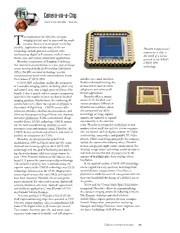
NASA Technical Reports Server (NTRS) 20020063415: Camera-on-a-Chip PDF
Preview NASA Technical Reports Server (NTRS) 20020063415: Camera-on-a-Chip
Camera-on-a-Chip Commercial Benefits—Spinoffs The requirement for low-cost, compact imaging systems used in spacecraft has made cameras the size of a computer microchip possible. Applications of this state-of-the-art Photobit Corporation’s technology include personal computer video camera-on-a-chip is conferencing, digital still cameras, medical instru- the result of a license ments, toys, and various automotive applications. granted to use NASA’s Photobit Corporation of Pasadena, California, CMOS-APS first received exclusive license to a new type of image technology. sensor developed at the Jet Propulsion Laboratory (JPL). The JPL-invented technology was the complementary metal-oxide semiconductor Active Pixel Sensor (CMOS-APS). mability via a serial interface. CMOS-APS technology enables the integration Besides videoconferencing, the of a complete imaging system, including pixel array devices will be used in video and control area, onto a single piece of silicon. One cell phones and other small- benefit is that it greatly reduces power consumption format applications. and lowers the number of parts needed in finished Photobit offers a unique imaging products. Furthermore, by combining all choice of off-the-shelf and camera functions—from the capture of photons to custom products. Officials at the output of digital bits—CMOS sensors offer Photobit are confident about enhanced reliability, facilitate miniaturization, and the commercial use of the allow on-chip programming of frame size, exposure, technology, as image capture and other parameters. Unlike conventional charge- markets are expected to expand coupled device (CCD) technology, CMOS sensors exponentially in the next few use the same manufacturing platform as most years. Photobit is aiming this technology at new microprocessors and memory chips. Therefore, the markets where small size and low power consump- CMOS devices are more cost-effective and easier to tion are needed, such as digital cameras, PC video produce in comparison to CCDs. conferencing, camcorders, and portable PC video Photobit, an entrepreneurial spinoff firm phones. Other areas being pursued by the company established in 1995 and based upon the JPL work, include the automotive industry, where Photobit obtained the licensing rights to the CMOS-APS devices can provide night vision enhancement. For technology with the goal of furthering and market- instance, image sensor technology would be used in ing the revolutionary solid state image sensor. In rear view mirrors that dim in proportion to the early 1999, Photobit announced the issuance of a amount of headlight glare from trailing vehicle broad U.S. patent for camera-on-a-chip technology. headlights. The company’s priority now is demonstrating the In the medical market, CMOS-APS technology superior nature of the CMOS technology over CCD can be tapped for x-ray products, including bone technology introduced in the 1970s. High-perfor- mineral density measurements. This allows a mance digital sensors that use CMOS architecture physician to track the onset of osteoporosis with less have been created at Photobit, “to set new perfor- than one-hundredth the dosage of a dental x-ray to mance standards for videoconferencing, digital still the patient. cameras, broadcast television, medical, agricultural, NASA and the United States Space Foundation and children’s applications,” says Photobit’s CEO recognized Photobit’s efforts in commercializing and founder Sabrina Kemeny. the compact imaging system by inducting Kemeny; Two new products in Photobit’s line of off-the- Eric Fossum, chairman and chief scientist; shelf videoconferencing chips were unveiled in 1999. Robert Nixon, deputy product division manager; The new sensors produce color or monochrome full- Barmak Mansoorian, new-product marketing frame 8-bit digital video at 30 frames per second. manager; and Roger Panicacci, senior engineer, into They feature electronic pan, tilt, and zoom, auto- the Space Technology Hall of Fame. v exposure (with manual override), and full program- Consumer/Home/Recreation 55
